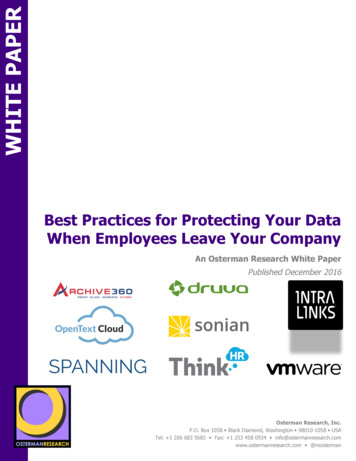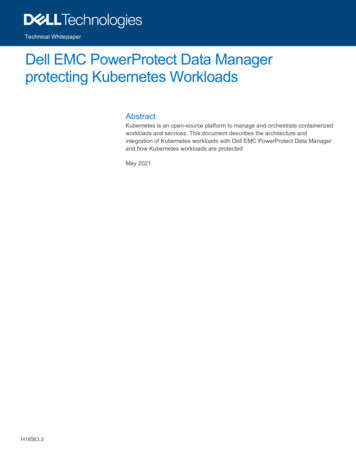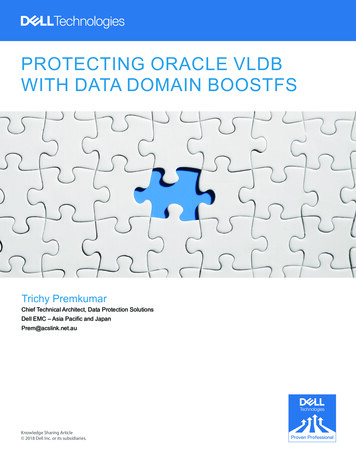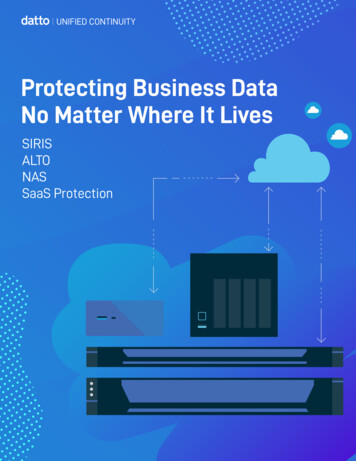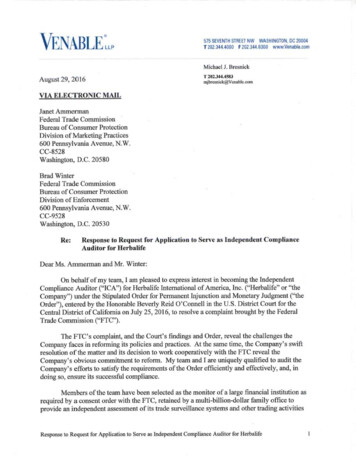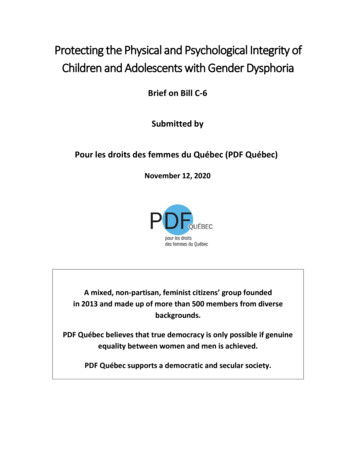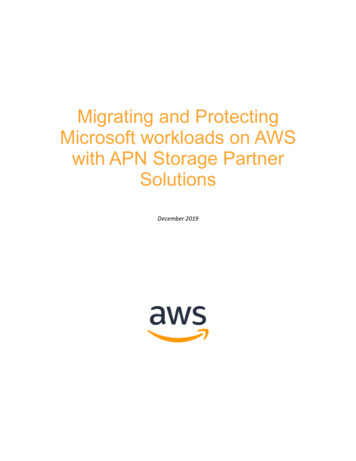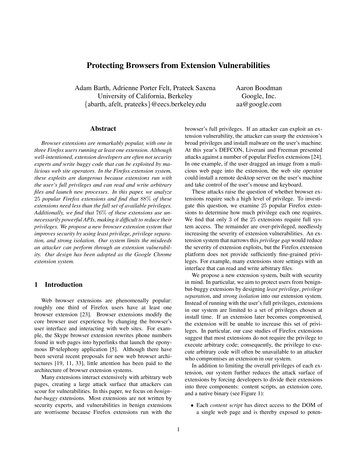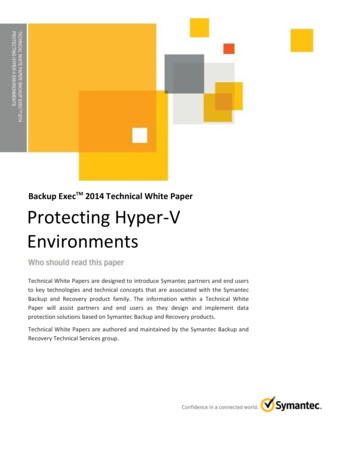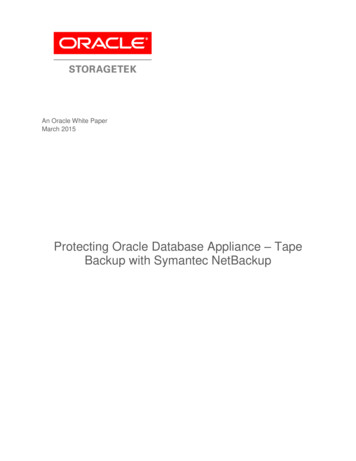
Transcription
Master ThesisElectrical EngineeringNovember 2011Security Techniques for Protecting Data inCloud ComputingVenkata Sravan Kumar MaddineniShivashanker RagiSchool of ComputingBlekinge Institute of TechnologySE - 371 79 KarlskronaSwedeni
This thesis is submitted to the School of Computing at Blekinge Institute of Technology inpartial fulfillment of the requirements for the degree of Master of Science in SoftwareEngineering. The thesis is equivalent to 40 weeks of full time studies.Contact Information:Author(s):Venkata Sravan Kumar MaddineniKarlskrona, Swedensravanmusic@gmail.comShivashanker RagiKarlskrona, Swedenragis38@gmail.comExternal advisor(s):Mj Jens KvarnbergSwedish Armed Forcesjens.kvarnberg@mil.seMr. Ross W TsagalidisSwedish Armed Forceswross@tele2.seUniversity advisor:Prof. Lars Lundberg, PhDSchool of Computinglars.lundberg@bth.seSchool of ComputingBlekinge Institute of TechnologySE - 371 79 KarlskronaSwedenInternetPhoneFax: www.bth.se/com: 46 455 38 50 00: 46 455 38 50 57ii
ABSTRACTContext: From the past few years, there has been a rapid progress inCloud Computing. With the increasing number of companies resorting touse resources in the Cloud, there is a necessity for protecting the data ofvarious users using centralized resources. Some major challenges that arebeing faced by Cloud Computing are to secure, protect and process the datawhich is the property of the user.Aims and Objectives: The main aim of this research is to understandthe security threats and identify the appropriate security techniques used tomitigate them in Cloud Computing.The main objectives of this research are: To understand the security issues and the techniques used in thecurrent world of Cloud Computing. To identify the security challenges, those are expected in the futureof Cloud Computing. To suggest counter measures for the future challenges to be faced inCloud Computing.Research Methodology: In this study, we have used two researchmethods. Systematic Literature Review. Survey and interviews with various security experts working onCloud Computing.Result: As a result, we have identified the total of 43 securitychallenges and 43 security techniques. The most measured attribute isconfidentiality (31%) followed by integrity (24%) and availability (19%).The impact of identified mitigation techniques is mainly on security (30%),followed by performance (22%) and efficiency (17%). Also we haveidentified 17 future challenges and 8 mitigation practices.Conclusion: The identification of security challenges and mitigationtechniques in large number of services of Cloud Computing is a verychallenging task. In the process of identification from research methods(SLR and Survey), we had identified a satisfactory number of challengesand mitigation techniques which are being used at present and also in futureCloud Computing.Keywords: Challenges, Cloud Computing, Security, Techniques.iii
ACKNOWLEDGEMENTAny attempt at any level can‟t be satisfactorily completed without the support andguidance of our professor. We would like to express our immense gratitude to ourProf. Lars Lundberg for his constant support and motivation that has encouraged us tocome up with this project. We are very thankful to our professor who has renderedtheir whole hearted support at all times for the successful completion of this thesis“Security Techniques for Protecting Data in Cloud Computing”. Furthermore, we arevery much thankful to Mr. Jens Kvarnberg and Mr. Ross W Tsagalidis for theirsupport and help throughout the research.We would also like to thank our survey participants who have contributed towardssurvey part of this thesis. Finally, we are greatly thankful to our beloved parents andfriends for their relentless support that they had given us to reach our goals.Yours truly,Venkata Sravan Kumar Maddineni,Shivashanker Ragi.iv
CONTENTSSECURITY TECHNIQUES FOR PROTECTING DATA IN CLOUD COMPUTING .IABSTRACT . IIIACKNOWLEDGEMENT .IVCONTENTS . VLIST OF FIGURES . VIILIST OF TABLES .VIII1INTRODUCTION . 21.11.21.32AIMS AND OBJECTIVES . 3RESEARCH QUESTIONS . 4THESIS OUTLINE . 4BACK GROUND . 62.1WHAT IS CLOUD COMPUTING? . 62.1.1 Definition of Cloud Computing . 62.1.2 Essential Characteristics of Cloud Computing . 62.1.3 Service Models of Cloud Computing . 72.1.4 Deployment Models of Cloud Computing . 72.2DRIVERS OF CLOUD COMPUTING . 82.3IMPORTANCE OF SECURITY IN CLOUD COMPUTING . 92.4IMPORTANT SECURITY ISSUES IN THE CLOUD . 103RESEARCH METHODOLOGY . 123.1SYSTEMATIC LITERATURE REVIEW (SLR) . 133.1.1 The rationale for SLR . 133.2SURVEY . 133.3DATA ANALYSIS METHODS . 143.3.1 Narrative Analysis . 143.3.2 Comparative Analysis . 144SYSTEMATIC LITERATURE REVIEW (SLR) . 164.1PLANNING THE REVIEW . 164.1.1 The need for a Systematic Literature Review . 164.1.2 Defining the research questions. 164.1.3 Defining Keywords . 174.1.4 Study Quality Assessment . 174.1.5 Review Protocol . 184.1.6 Selection Criteria and Procedures . 184.2CONDUCTING THE REVIEW . 184.2.1 Data Extraction Strategy . 184.2.2 Identification of Research . 194.2.3 Study Selection Criteria . 194.2.4 Reliability of Inclusion . 255SURVEY . 275.15.25.35.4RATIONALE FOR SURVEY . 27SOURCE OF DATA COLLECTION . 27SURVEY QUESTIONS FORMATION . 27SURVEY ADMINISTRATION . 27v
6RESULTS AND ANALYSIS. 296.1SLR RESULTS . 296.1.1 Identified Challenges . 296.1.2 Identified Mitigation Techniques . 306.2SURVEY RESULTS . 316.2.1 Reported challenges . 336.2.2 Reported Mitigation Techniques . 337VALIDITY THREATS . 367.1CONSTRUCT VALIDITY. 367.2INTERNAL VALIDITY . 367.2.1 Data Gathered Through Interview . 367.3EXTERNAL VALIDITY . 377.4CONCLUSION VALIDITY . 378CONCLUSION . 398.18.28.38.48.59FOR RESEARCH QUESTION: 1 . 39FOR RESEARCH QUESTION: 2 . 39FOR RESEARCH QUESTION: 3 . 40FOR RESEARCH QUESTION: 4 . 41FUTURE WORK . 41REFERENCES. 43APPENDIX A. 50APPENDIX B . 56APPENDIX C. 63APPENDIX D. 66APPENDIX E . 67vi
LIST OF FIGURESFigure 1.1 Unauthorized access of data between the network and Cloud . 2Figure 1.2 Unauthorized access of data within the Cloud . 3Figure 1.3 Thesis outline . 4Figure 2.1 Importance of Security in Cloud Computing . 9Figure 3.1 Research Design . 12Figure 4.1 Steps of Systematic Literature Review . 20Figure 4.2 IEEE search interface . 21Figure 4.3 Springer link search interface . 22Figure 4.4 Science Direct search interface . 23Figure 4.5 Scopus search interface . 23Figure 6.1 Number of papers published in year wise . 29Figure 6.2 List of Compromised attributes . 30Figure 6.3 Impact of mitigation techniques . 31vii
LIST OF TABLESTable 4.1 Defining Research Questions . 17Table 4.2 Quality assessment checklist . 17Table 4.3 Selection Criteria . 18Table 6.1 List of experts interviewed . 32viii
CHAPTER 1INTRODUCTION1
1INTRODUCTIONFrom the past few years, there has been a rapid progress in Cloud Computing.Cloud Computing delivers a wide range of resources like computational power,computational platforms, storage and applications to users via internet. The majorCloud providers in the current market segment are Amazon, Google, IBM, Microsoft,Salesforce, etc. With an increasing number of companies resorting to use resources inthe Cloud, there is a necessity for protecting the data of various users. Some majorchallenges that are being faced by Cloud Computing are to secure, protect and processthe data which is the property of the user. Below, we have described the two mainstates that hold your data is out in the Cloud: when the data is in motion (transit) andwhen the data is at rest, where the data is much expected to be more secure. The belowillustrated are the two main scenarios which we have focused to understand thesecurity of the data in the Cloud.Figure 1.1 Unauthorized access of data between the network and CloudThe above figure 1.1 describes a scenario where a local network is connected to aCloud network, in which some part of the network data is broken out from the localnetwork and placed in the Cloud, but the critical data resides in the local networkitself. In this case, the Cloud provider does not have any privilege of accessing the dataphysically which is in the local network. But in some cases, the Cloud needs to accesssome information which is in the local network, during that access; there exists apossibility of unauthorized access of the local network resources. It describes thetypical problem in network security where the information can face active attacks andpassive attacks. The active attacks include masquerading, replay attack, modificationof messages and denial of service. Passive attacks include traffic analysis. Theseattacks are likely to happen when the stream of information leaves the client networkto the Cloud network.2
Figure 1.2 Unauthorized access of data within the CloudThe above figure 1.2 describes the scenario where the total data of the localnetwork resides within the Cloud, where the local network and the authorized userscan access their data physically in the Cloud. At that instant of time, there exists apossibility for unauthorized users to enter and access the data in the Cloud. In thissituation, the virtual machines are allotted to users of the Cloud. These machines havevalid logins. However, these logins can be abused and cracked. The data may also beaccessed in other perverted ways.Regarding this area of study, most of the research papers followed a normaltraditional literature survey method. Few papers gave an innovative idea and proposeda security model. However, there are very few works, which considered the opinionsof various security experts in Cloud Computing. This study proposes that, reader getsthe true reflection of the security practices followed by various Cloud Computingcompanies in the current era. There are very few papers which focus on the securitytechniques for specified applications. Our work provides more knowledge in thisdimension and also predicts the future threats likely to be faced by Cloud Computingand solutions to these threats.1.1Aims and ObjectivesThe main aim of this research work is to identify and understand the securityissues which affect the performance of Cloud Computing. Also, to understand thesecurity techniques which are being used to mitigate these security issues. Therebyproviding the standard guidelines for the Cloud service providers and as well as Cloudusers.The main objectives of this research are: To understand the security issues and to identify the appropriate securitytechniques those are being used in the current world of Cloud Computing. To identify the security challenges those are expected in the future of CloudComputing. To suggest some counter measures for the future challenges to be faced inCloud Computing.3
1.2Research QuestionsResearch Question 1: what are the various security techniques being used by theleading Cloud Computing providers, to prevent active and passive attacks when thedata is being transferred between the Cloud and a local network?Research Question 2: what are the various security techniques being used toprevent unauthorized access to data within the Cloud?Research Question 3: what are the major security challenges we expect in futureCloud Computing?Research Question 4: How can we handle security problems that are expected infuture Cloud Computing?1.3Thesis outlineFigure 1.3 Thesis outlineThe document is organized as follows: Chapter 1 discusses a brief introduction of theconcepts used in this thesis and Chapter 2 discusses the background of Cloud Computing.The research methodologies and the data analysis used are presented in chapter 3. Theprocess of Systematic Literature review is discussed in chapter 4 followed by a briefoverview of Survey is discussed in chapter 5. The results from the Systematic LiteratureReview and Survey are presented in chapter 6. The validity threats of our thesis from variousperspectives are discussed in chapter 7. Finally, the conclusion and future directions arediscussed in chapter 8. The references used are cited and appendixes are referred at the endof the document.4
CHAPTER 2BACKGROUND5
2 BACK GROUNDThis chapter provides a brief overview about background of CloudComputing. Section 2.1 provides the standard definition of Cloud Computing and itsessential characteristics, services, deployment models respectively. The section 2.2gives brief information about the Cloud Computing providers. Section 2.3 deals withthe importance of security in the Cloud Computing, whereas section 2.4 provides themajor security issues in Cloud.2.1 What is Cloud Computing?Cloud is a computing model that refers to both the applications derived as servicesover the Internet, the hardware and system software in the datacenters that providethose services. Cloud Computing is treated as the high potential paradigm used fordeployment of applications on Internet. This concept also explains the applications thatare broaden to be accessible through the Internet. Cloud applications use large datacenters and effective servers that host web applications and services.2.1.1 Definition of Cloud ComputingCloud Computing is rapidly being accepted as a universal access appliance on theInternet. A lot of attention has been given to the Cloud Computing concept in derivingstandard definitions. However, the definitions of Cloud Computing remaincontroversial. But here we have considered the standard definition which was given bythe National Institute of Standards and Technology (NIST):“Cloud Computing is model for enabling ubiquitous, convenient, on demandnetwork access to a shared pool of configurable computing resources (e.g., networks,servers, storage, applications and services) that can be rapidly provisioned andreleased with minimal management effort or service provider interaction”, [44].2.1.2 Essential Characteristics of Cloud ComputingAccording to NIST, the Cloud model is composed of five essential characteristics: On-demand self-service: A consumer can unilaterally provision computingcapabilities, such as server time and network storage, as needed automaticallywithout requiring human interaction with each service provider [44]. Broad network access: Capabilities are available over the network andaccessed through standard mechanisms that promote use by heterogeneous thinor thick client platforms (e.g., mobile phones, tablets, laptops, and workstations)[44]. Resource pooling: The provider’s computing resources are pooled to servemultiple consumers using a multi-tenant model, with different physical andvirtual resources dynamically assigned and reassigned according to consumerdemand. There is a sense of location independence in that the customergenerally has no control or knowledge over the exact location of the providedresources but may be able to specify location at a higher level of abstraction(e.g., country, state, or datacenter). Examples of resources include storage,processing, memory, and network bandwidth [44].6
Rapid elasticity: Capabilities can be elastically provisioned and released, insome cases automatically, to scale rapidly outward and inward commensuratewith demand. To the consumer, the capabilities available for provisioning oftenappear to be unlimited and can be appropriated in any quantity at any time [44]. Measured service: Cloud systems automatically control and optimize resourceuse by leveraging a metering capability (pay-per-use basis) at some level ofabstraction appropriate to the type of service (e.g., storage, processing,bandwidth, and active user accounts). Resource usage can be monitored,controlled, and reported, providing transparency for both the provider andconsumer of the utilized service [44].2.1.3 Service Models of Cloud ComputingAccording to NIST, the cloud model is composed of three service models: Software as a Service (SaaS): The capability provided to the consumer is to usethe provider’s applications running on a cloud infrastructure. The applicationsare accessible from various client devices through either a thin client interface,such as a web browser (e.g., web-based email), or a program interface. Theconsumer does not manage or control the underlying cloud infrastructureincluding network, servers, operating systems, storage, or even individualapplication capabilities, with the possible exception of limited user-specificapplication configuration settings [44]. Platform as a Service (PaaS): The capability provided to the consumer is todeploy onto the cloud infrastructure consumer-created or acquired applicationscreated using programming languages, libraries, services, and tools supported bythe provider. The consumer does not manage or control the underlying cloudinfrastructure including network, servers, operating systems, or storage, but hascontrol over the deployed applications and possibly configuration settings for theapplication-hosting environment [44]. Infrastructure as a Service (IaaS): The capability provided to the consumer is toprovision processing, storage, networks, and other fundamental computingresources where the consumer is able to deploy and run arbitrary software, whichcan include operating systems and applications. The consumer does not manageor control the underlying cloud infrastructure but has control over operatingsystems, storage, and deployed applications; and possibly limited control of selectnetworking components (e.g., host firewalls) [44].2.1.4 Deployment Models of Cloud ComputingAccording to NIST, the cloud model is composed of four deployment models: Private cloud: The cloud infrastructure is provisioned for exclusive use by a singleorganization comprising multiple consumers (e.g., business units). It may beowned, managed, and operated by the organization, a third party, or somecombination of them, and it may exist on or off premises [44].7
Community cloud: The cloud infrastructure is provisioned for exclusive use by aspecific community of consumers from organizations that have shared concerns(e.g., mission, security requirements, policy, and compliance considerations). Itmay be owned, managed, and operated by one or more of the organizations in thecommunity, a third party, or some combination of them, and it may exist on or offpremises [44]. Public cloud: The cloud infrastructure is provisioned for open use by the generalpublic. It may be owned, managed, and operated by a business, academic, orgovernment organization, or some combination of them. It exists on the premisesof the cloud provider [44]. Hybrid cloud: The cloud infrastructure is a composition of two or more distinctcloud infrastructures (private, community, or public) that remain unique entities,but are bound together by standardized or proprietary technology that enablesdata and application portability (e.g., cloud bursting for load balancing betweenclouds) [44].2.2 Drivers of Cloud ComputingCloud Computing is rapidly growing area in the IT security space because Cloudarchitectures are popping up all over. The major driving thought Cloud providerspresent in the current market segment are Amazon, Microsoft, Google, IBM,Oracle, Eucalyptus, VMware, Eucalyptus, Citrix, Salesforce, Rackspace and thereare many different vendors offering different Cloud services. The cloud providersare having different forms to provide their services [18]: Amazon: Amazon Web Services including the Elastic Compute Cloud(EC2), Amazon Simple Storage Service (S3), etc.- Provides a highly scalable computing platform to the customer withhigh flexibility and availability to build a wide range of applications. Google: Google App Engine- It supports application programming interfaces for the data store,image manipulation, Google accounts and e-mail services. Microsoft: Windows Azure Platform- Windows Azure platform is a group of Cloud technologies whichprovides a specific set of services to application developers. Eucalyptus- Eucalyptus is an open source software infrastructure to create privateCloud architecture on existing enterprise.IBM: Lotus Live (Platform as a Service)Salesforce: (Software as a Service)Rackspace Cloud: (formerly Mosso)VMware: Provide Virtualization infrastructure 8
2.3 Importance of Security in Cloud ComputingFigure 2.1 Importance of Security in Cloud Computing(Source: g/cloud-computingv26.ppt at slide 17.)The above statistical resulted graph represents the results of the survey whichwas conducted by the IDC (International Data Corporation) in August, 2008 amongstsenior business executives and IT professionals regarding the challenges/issues whichmainly affect the performance of Cloud Computing. And the survey results showsecurity at the top of the list which declares its importance compared to otherparameters of Cloud Computing.During a keynote speech to the Brookings Institution policy forum, “CloudComputing for Business and Society”, Microsoft General Counsel Brad Smith alsohighlighted data from a survey commissioned by Microsoft for measuring attitudes onCloud Computing among business leaders and the general population in January 2010.The survey found that while 58% of the general population and 86% of the seniorbusiness leaders are very much excited about the potential of Cloud Computing andmore than 90% of these same people are very much concerned about the security,access and privacy of their own data in the Cloud. (Source: 0/1-20BrookingsPR.mspx).The survey results show that the security is the major challenge amongst allthe parameters that affect the performance and growth of Cloud Computing.9
2.4 Important Security Issues in the CloudEven though, the virtualization and Cloud Computing delivers wide range of dynamicresources, the security concern is generally perceiv
current world of Cloud Computing. To identify the security challenges, those are expected in the future of Cloud Computing. To suggest counter measures for the future challenges to be faced in Cloud Computing. Research Methodology: In this study, we have
